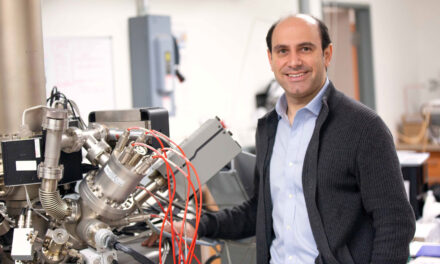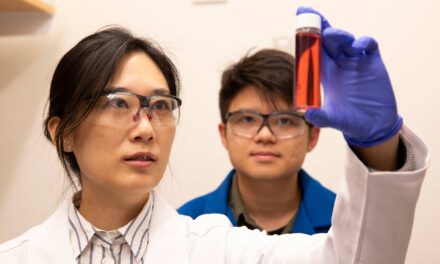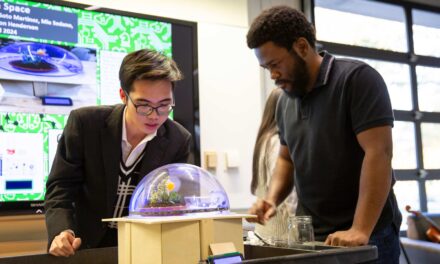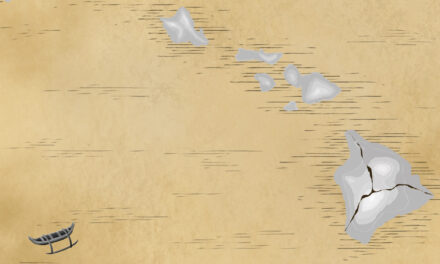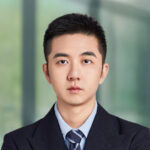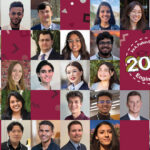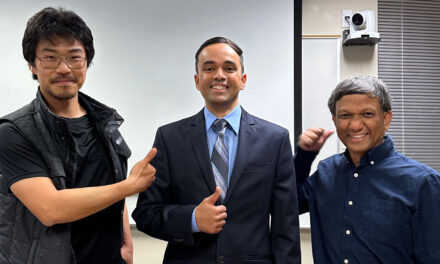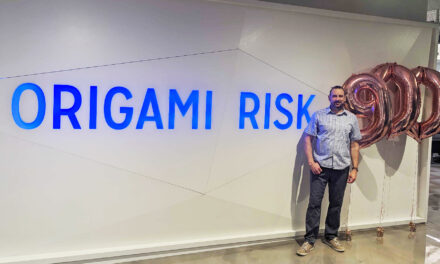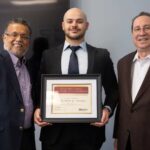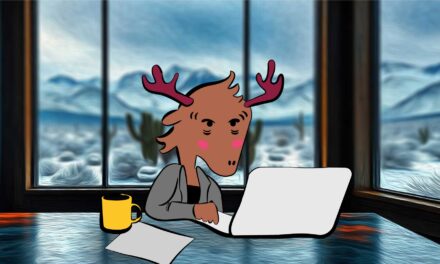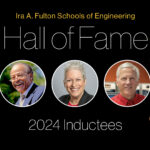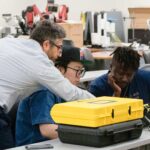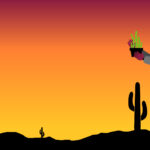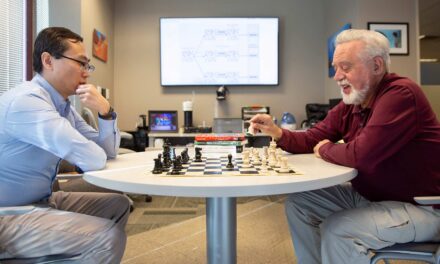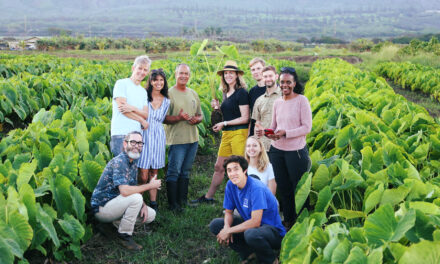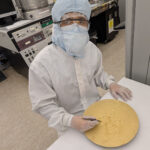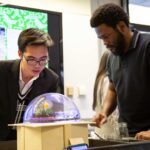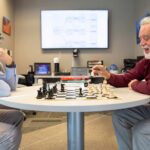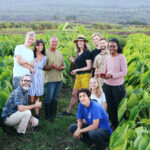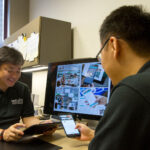
Integrated engineering on display
Project Showcase exhibits students’ creativity in seeking innovative solutions to technological challenges
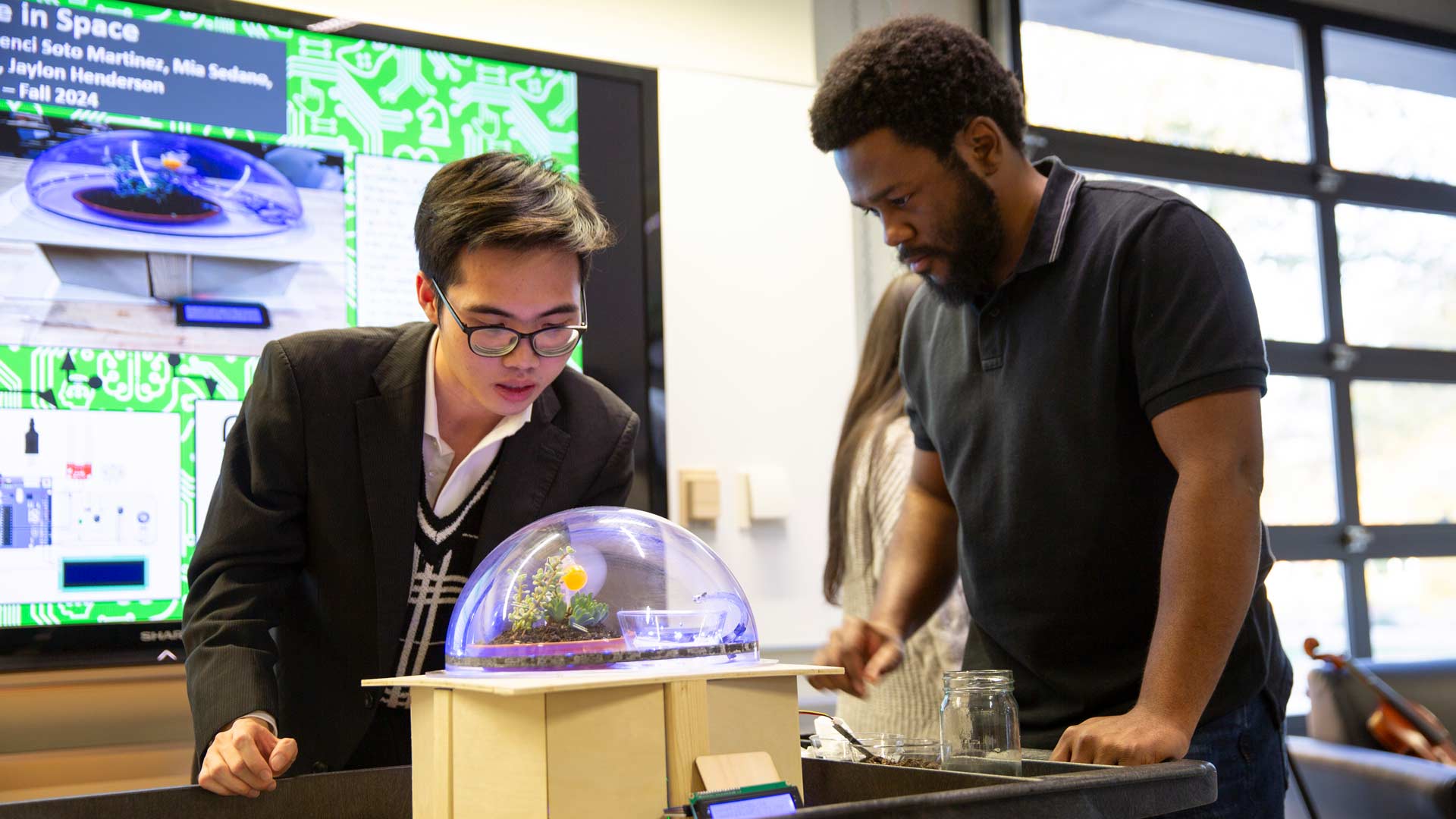
Students Tony Doan (at left) and mechanical engineering student Jaylon Henderson examine a model of a biome structure that is part of the display to illustrate a project titled “Sustainable Biome: Life in Space.” A team of students in the School of Integrated Engineering, part of the Fulton Schools of Engineering at Arizona State University, completed the project that illustrates ideas for technologies and systems that could sustain human life in climate on Mars during prolonged missions to explore the planet. Photographer: Erika Gronek/ASU[/caption]
A portable, lightweight, affordable, wearable drum set designed to be playable anytime, anywhere. It features sensors, high-quality sound output and a design that enables adding future technical enhancements.
A metronome that lets saxophone players to practice alone but incorporates tools to simulate performing with tools to simulate performing with a musical ensemble. It offers a wearable option of being easily worn and provides easy-to-use and transportable devices to enrich the musical practice and performance experience.
An array of simple but versatile devices that make it possible for musicians who are visually impaired to follow an orchestra conductor’s directions. It includes programmable tools that interact with hardware devices using software programs.
These were three examples of prototypes on display at the recent Project Showcase, an exhibition event for students who developed projects to enrich musical experiences by applying engineering capabilities.
The event spotlighted work by several student teams in the Ira A. Fulton Schools of Engineering at Arizona State University, with most participants enrolled in the School of Integrated Engineering, the newest of the eight Fulton Schools.
Twenty-six students who took the Fulton Schools’ fall 2024 offering of Introduction to Engineering course taught by Assistant Professor Joana Sipe at ASU’s West Valley campus gathered for the showcase and demonstration event at Changemaker Central.
The facility serves as a resource hub operated largely by students involved in academic and co-curricular activities that emphasize service learning, social entrepreneurship, civic engagement and community service. Its mission is to empower student-driven initiatives that promote positive social change.
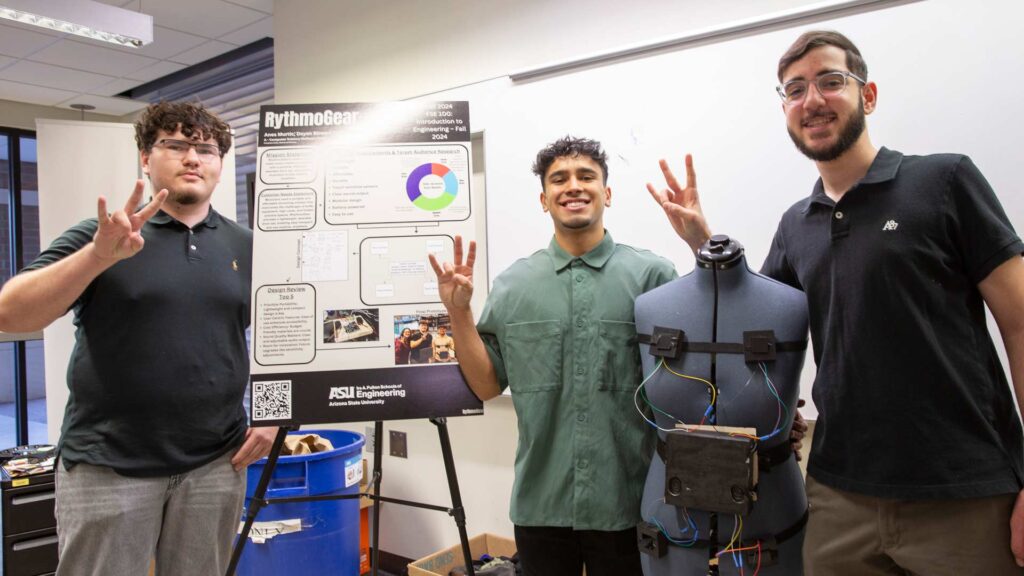
The project RythmoGear involved devising ideas and designs to provide easily transportable technology to enable drummers to practice or perform in almost any setting or environment. The system would be cost-efficient, lightweight, provide quality percussion sounds, be battery powered and allow for future options to enhance its performance. Students Anes Murtic, Dayan Birwani and Luis Arroyo completed the project. Photographer: Erika Gronek/ASU
Enhancing healthcare, cultural and sustainability endeavors
Sipe describes the goal of this Project Showcase as challenging students to “implement engineering concepts through an integrated engineering lens,” giving them opportunities to engage in efforts aimed at making advances in three fields — health, music and sustainable engineering.
Sipe challenged students to conceptualize engineering-based solutions forone of three guiding premises: as a partnership with ASU’s forthcoming medical school; a project to create wearable music inspired by the work of Seth Thorn, an assistant professor in ASU’s School of Arts, Media and Engineering; or a sustainable engineering project aimed at reducing waste.
One of the directives challenged students to come up with ideas for advancing music performance and enabling more people to experience participating in it.
The drum set project was the work of computer systems engineering student Anes Murtic and computer science students Dayan Birwari and Luis Arroyo.
The saxophone metronome project team members were computer science student Hadia Abujbarah, microelectronics engineering students Abinay Jandarajupali and Kevin Shepard and engineering science and business student Peyten Osborn.
A project to help the visually impaired play musical instruments was the work of computer science students Matthew Arroyo, Hans Inocentes and Mert Isik, Adrian Rodriquez and Hans Inocentes and microelectronics student Mia Sedano.
Another project involved fashioning an improved shoulder rest for musicians who play violins and similar musical instruments. The team was comprised of electrical engineering student Cassie Watson, mechanical engineering student Tyler Sellito and microelectronics students William Zhuang and Vik Bellur.
Going beyond engineering’s technical aspirations with new applications
Engineering science and business students Magali Bautista and Yarenci Soto Martinez worked with Eknoor Kaur, a computer science student, to develop an attachable tuner for guitar players.
Kaur engaged in various aspects of three projects featured at the showcase event, each of which she says provided her valuable learning experiences.
For one effort, Kaur conceptualized the design of a detailed model of ASU’s forthcoming medical school. What began as a cardboard model was later translated into a version that can be visualized on a computer. The project “highlighted the balance between technical work and creativity,” she says.
Her team’s project and others, she adds, “helped me grow as a leader, learn to set boundaries, learn the meaning of fair teamwork and time management, and not to give up when things seem impossible.”

Professor Todd Sandrin (center), vice provost of ASU’s West Valley campus and dean of ASU’s New College of Integrative Arts and Sciences, joined School of Integrated Engineering Interim Director Shawn Jordan (right) and Assistant Professor Joana Sipe (left) to discuss future collaborations between their respective schools. Photographer: Erika Gronek/ASU
Putting sustainable engineering into practice
A student team involved in the Developing a More Accessible Composter project designed a machine that creates and maintains compost. The soil-like material is created by breaking down organic materials through a biological process, providing a way to recycle organic materials and return nutrients to the soil at ASU’s West Valley campus.
The project’s goals included providing an effective process for composting in a moist, heated environment to ensure the quality and efficiency of the material. The multidisciplinary team included electrical engineering student Cassie Watson computer science student Matthew Arroyo, engineering science student Peyten Osborn and mechanical engineering student Tyler Sellitto.
Sellito says the experience of working on both the musical instrument shoulder rest and the composting projects was an exceptional educational experience that went beyond the technical aspects of engineering projects into the economic and business aspects of the field.
“I’ve gained knowledge about how to get a better understanding of the needs of the customers for new technologies and how to ask them the important questions, such as what exactly are their needs and expectations for the performance of the product,” he says.
Sellito sees opportunities provided by events like the Projects Showcase as having especially positive impacts on students’ approach to engaging in efforts aimed at realizing their career aspirations. “It can give us real-world experience in dealing with the array of peoples’ needs and how to respond to them in productive and effective ways,” he says.
“It can give us real-world experience in dealing with the array of peoples’ needs and how to respond to them in productive and effective ways,” he says.
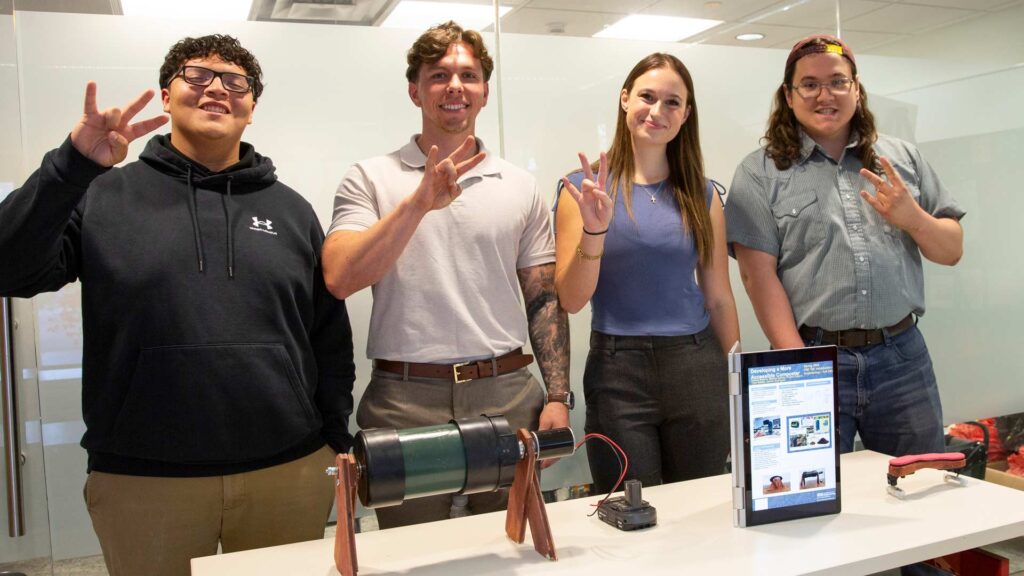
A composting machine with features enabling people to grow food in harsh climates not conducive to robust agriculture — like on other planets — challenged the creative skills of Fulton Schools students Cassie Watson, Tyler Sellito, Adrian Rodriguez, Mathew Arroyo and Peyten Osborn. Photographer: Erika Gronek/ASU
Eyeing entrepreneurial pathways
Also among these efforts was a project titled “Sustainable Biome: Life in Space,” by Magali Bautista, Yarenci Soto Martinez, Mia Sedano, Eknoor Kaur, engineering business-science student Vina Chalabee, software engineering student Tony Doan, and mechanical engineering student Jaylon Henderson.
Their mission involved designing a biodome to help enable humans to inhabit Mars. It included developing ideas for creating life sustaining environments that would enable producing and recycling food, water and oxygen. It would also protect humans from the planet’s dangerous radiation and harsh climate and provide ways to also help ensure the psychological well-being of the astronauts and and other explorers.
Laura Hawes, a senior coordinator of student success and engagement in engineering and student affairs at the West Valley Campus, echoed Sellito’s positive assessment of the showcase experience.
“The attendance was strong and the setting was inviting and welcoming not only for the students but for those who attended,” Hawes says. “Students were able to share what they created and I witnessed them talking proudly about their projects Having opportunities to get feedback from faculty and staff and guests is essential to the continued success of their work.”
Shawn Jordan, director of the School of Integrated Engineering, had a similarly positive view of the Projects Showcase outcome.
“Students were really enthusiastic about their projects, and it was impressive that they gave thought to many technical and creative aspects of their project designs. They also had good answers to questions about how they would move their work forward and pursue entrepreneurial pathways and create startup ventures,” Jordan says.
“They came up with a lot of creative and thoughtful solutions to problems. In our integrated engineering program, we want to prepare students to solve problems in partnership with many different kinds of communities,” he adds. “That’s the approach I think was reflected in the results of what these the project teams came up with.”
Jordan now plans to make the showcase event a part of every fall and spring semester that will be open to the entire ASU community as well as the general public.
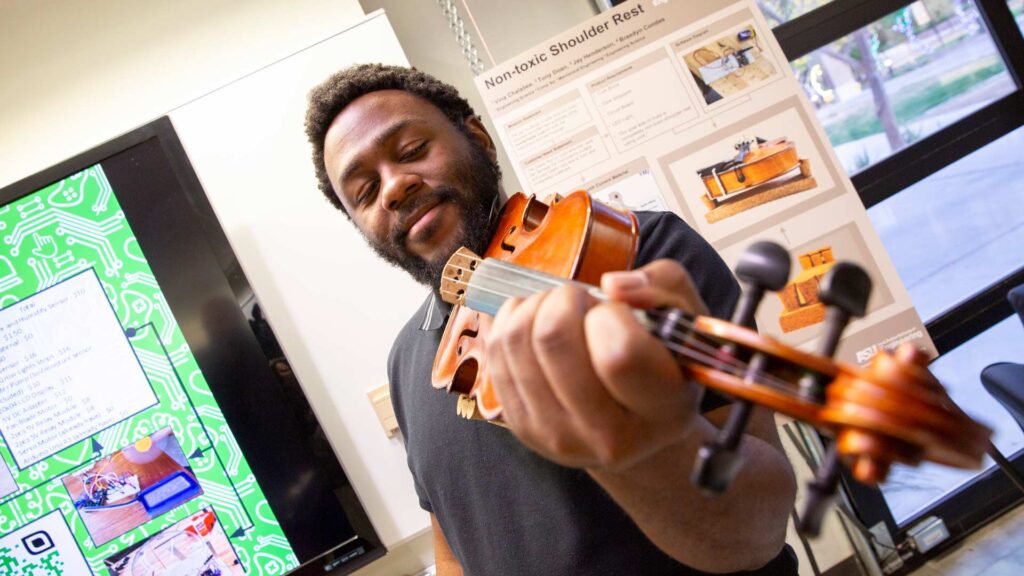
Student Jaylon Henderson plays a violin using a shoulder rest attached to the instrument that is designed to enhance the skill of musicians through features that ensure comfort and prevent physical stress while performing. Photographer: Erika Gronek/ASU


